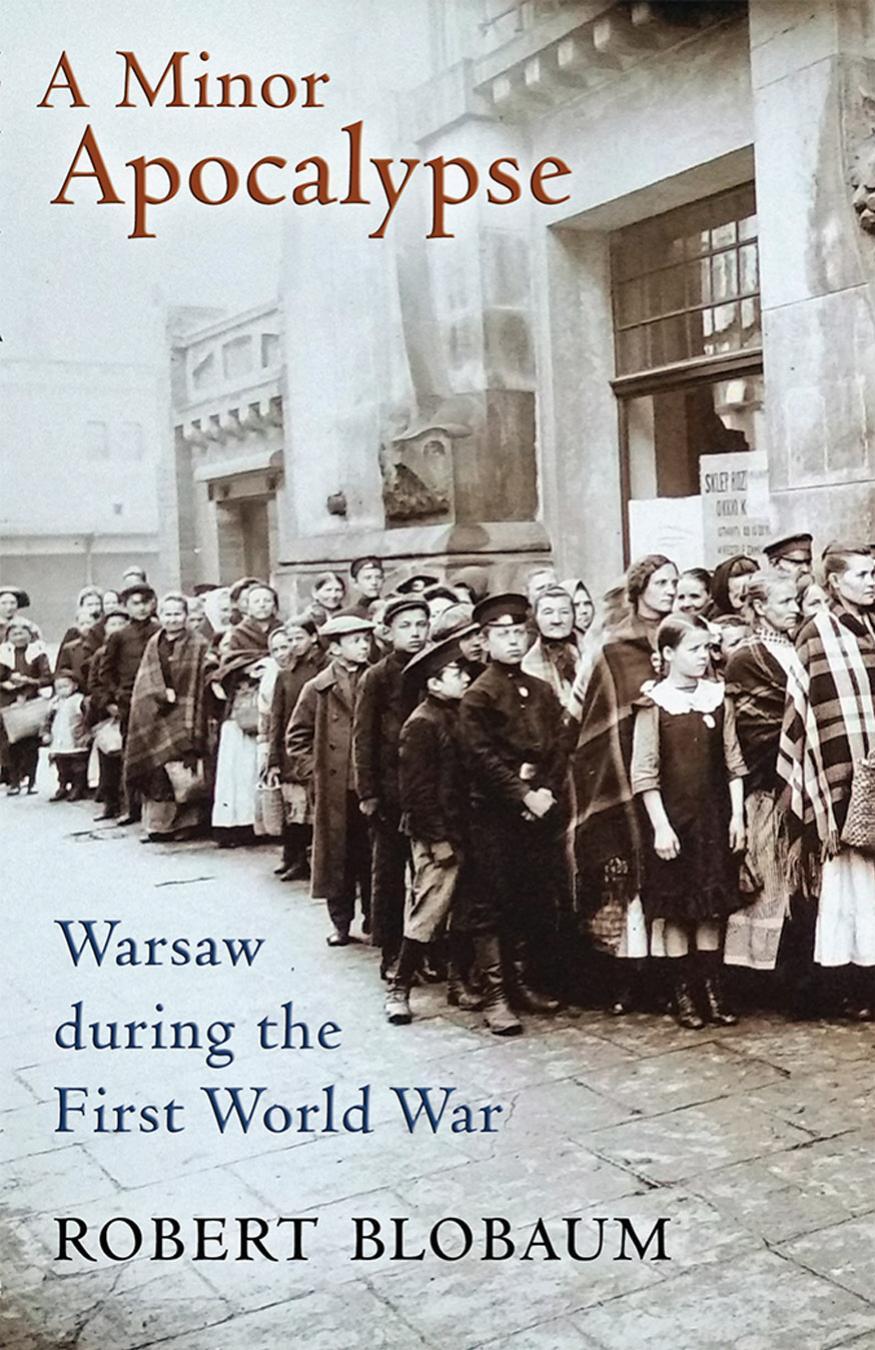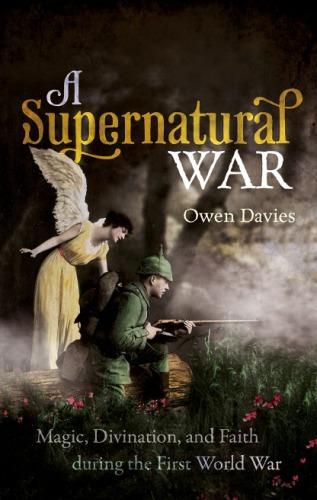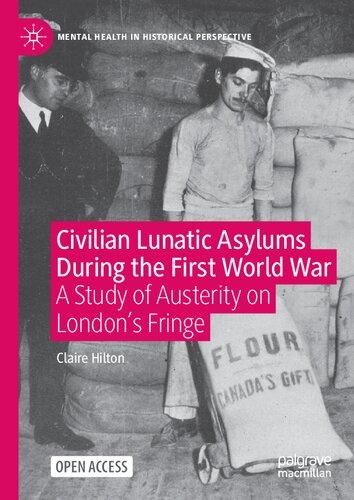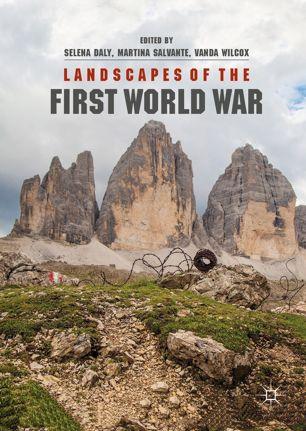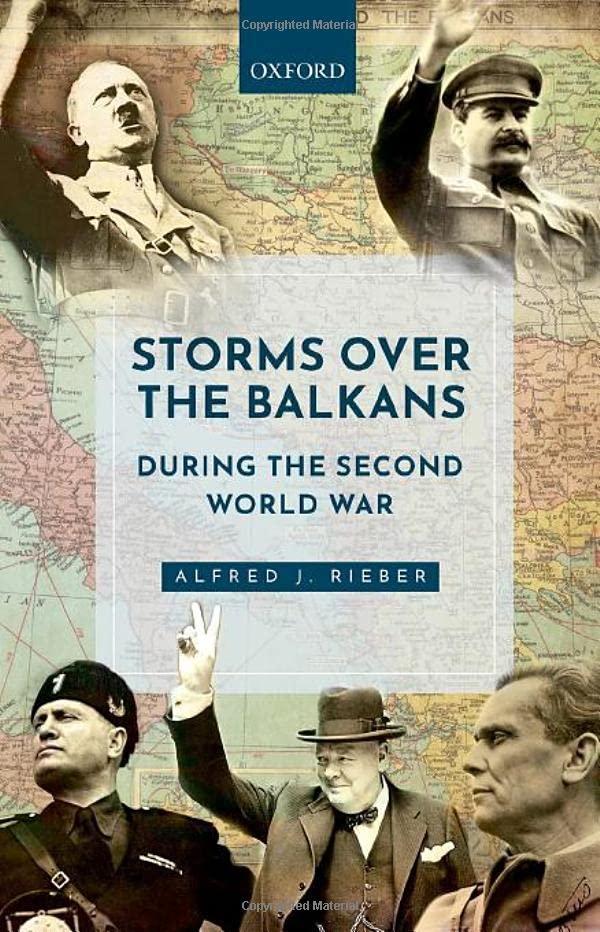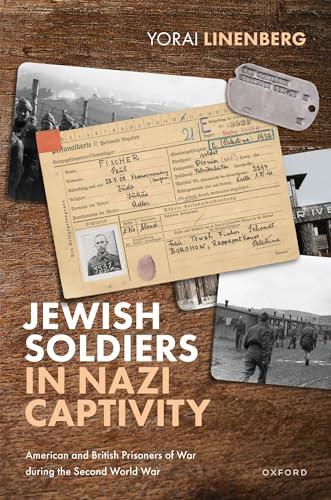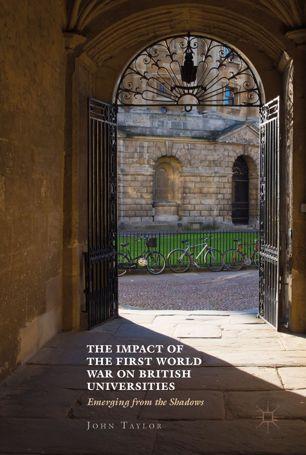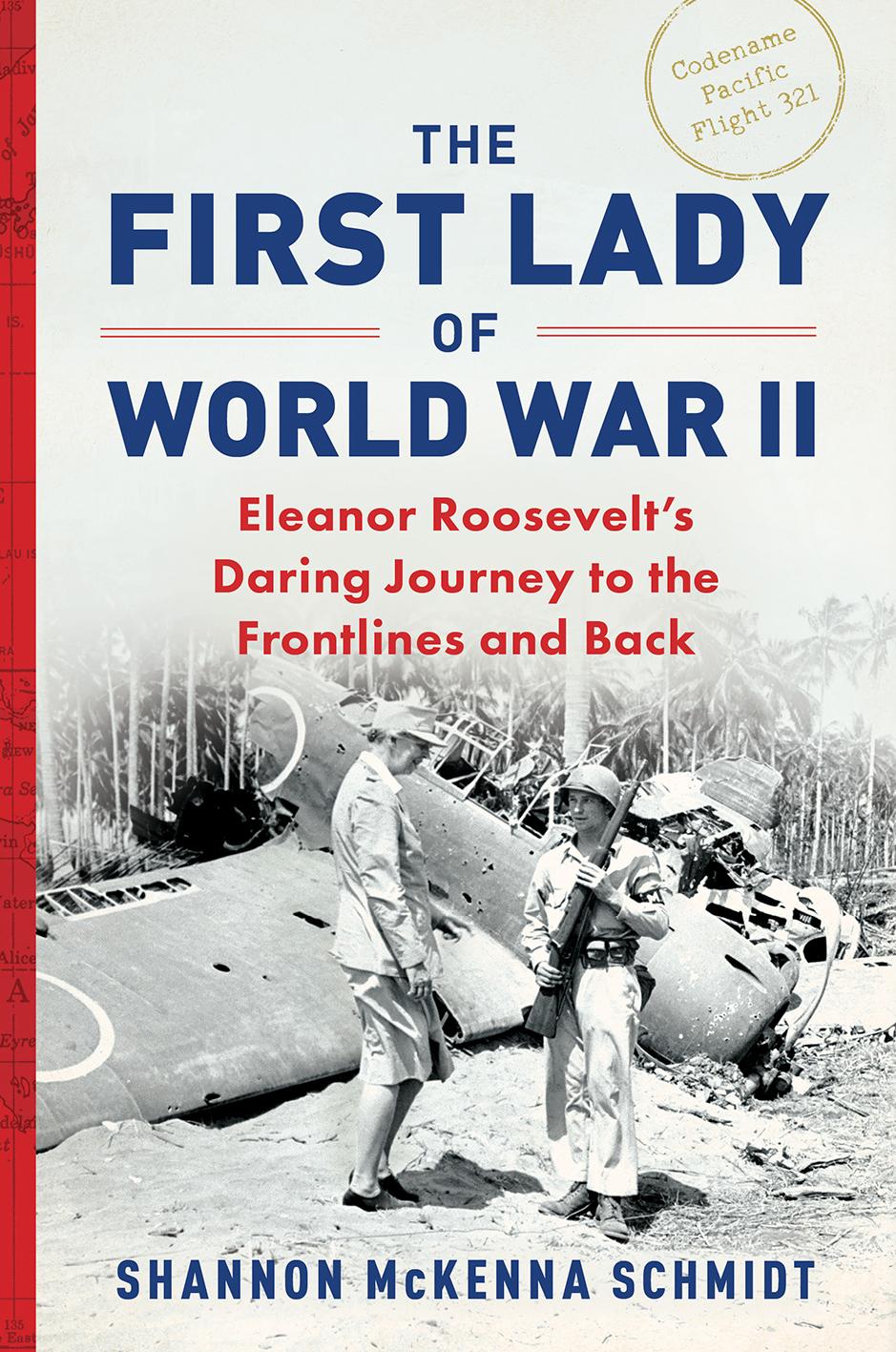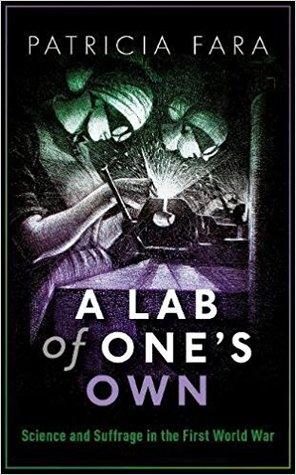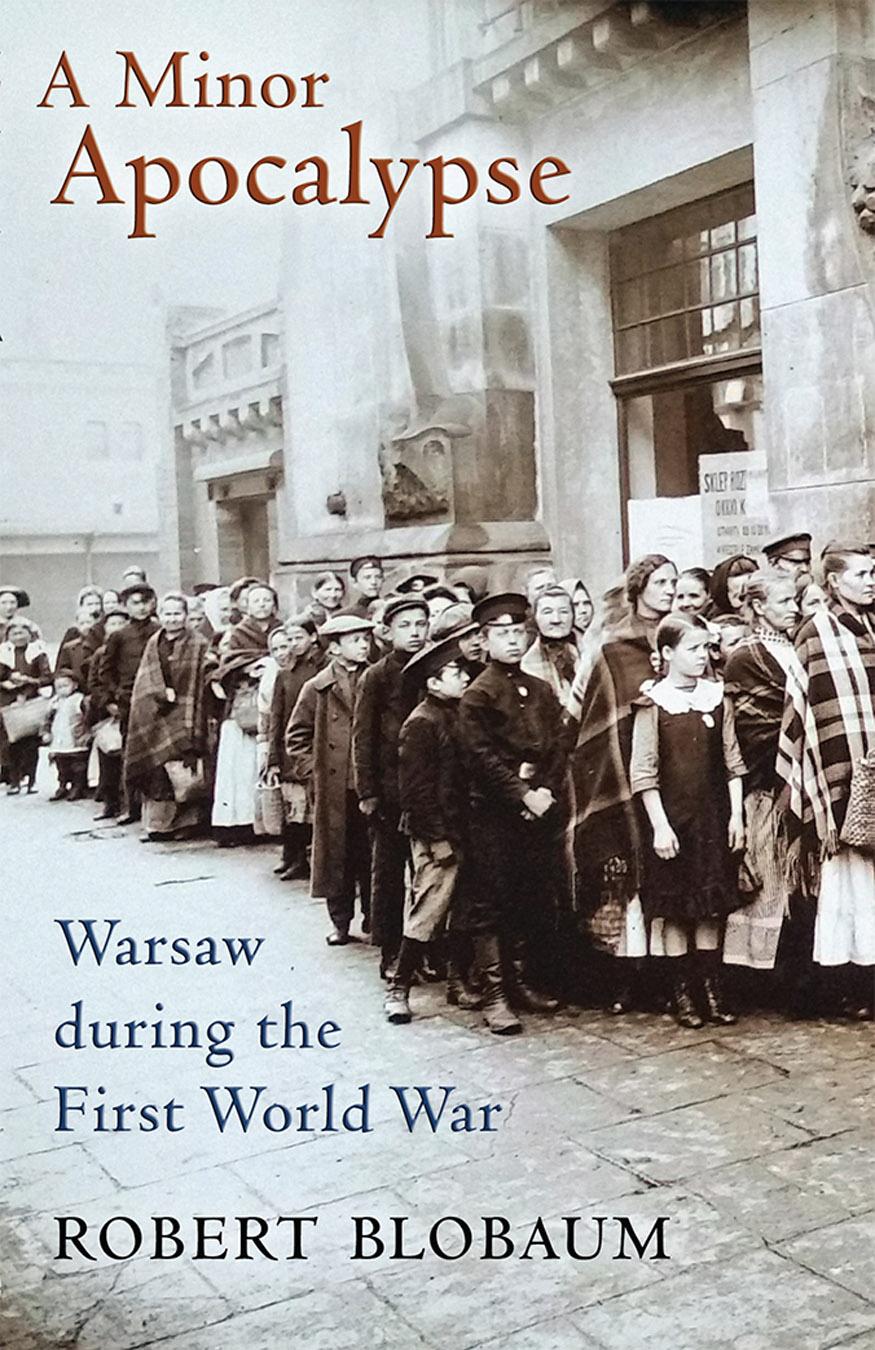A MINOR APOCALYPSE
Warsaw during the First World War
Robert Blobaum
This book was published with the generous support of West Virginia University.
Copyright © 2017 by Cornell University
All rights reserved. Except for brief quotations in a review, this book, or parts thereof, must not be reproduced in any form without permission in writing from the publisher. For information, address Cornell University Press, Sage House, 512 East State Street, Ithaca, New York 14850.
First published 2017 by Cornell University Press
Printed in the United States of America
Library of Congress Cataloging-in-Publication Data
Names: Blobaum, Robert, author.
Title: A minor apocalypse : Warsaw during the First World War / Robert Blobaum.
Description: Ithaca : Cornell University Press, 2017. | Includes bibliographical references and index.
Identifiers: LCCN 2016035605 | ISBN 9781501705236 (cloth : alk. paper) | ISBN 9781501707889 (pdf) | ISBN 9781501707872 (epub/mobi)
Subjects: LCSH: Warsaw (Poland)—History—20th century. | World War, 1914–1918—Social aspects—Poland—Warsaw.
Classification: LCC DK4632 .B55 2017 | DDC 940.3/43841—dc23
LC record available at https://lccn.loc.gov/2016035605
Cornell University Press strives to use environmentally responsible suppliers and materials to the fullest extent possible in the publishing of its books. Such materials include vegetable-based, low-VOC inks and acid-free papers that are recycled, totally chlorine-free, or partly composed of nonwood fibers. For further information, visit our website at www.cornellpress.cornell.edu.
Cover photograph: A food line on Koszykowa Street, 1915. Source: Muzeum Narodowe, Podr. Muz. 0557, Album “ Ś wiatłoczule.”
Preface
“Do books write themselves?” I ask my students every time we begin a discussion of a new monograph. The purpose of this question, now repeated over thirty years of teaching, is to have students explore the personal and professional baggage authors bring to their writing, but the truth of the matter is that every piece of scholarship is a collective, collaborative enterprise. The single author of a monograph is at best a principal investigator who may take both responsibility and credit for the work and certain decisions associated with it, but would never have been in a position to do so without the assistance of many others, including those who have paved the historiographical highway.
The idea for this book was conceived some ten years ago as a much-needed update to the only existing social history of Warsaw during the First World War, Krzysztof Dunin-Wąsowicz’s Warszawa w czasie pierwszej wojny światowej (1974), which contained valuable data but otherwise lacked any kind of comparative perspective, ignored issues of gender and ethnicity, and was based solely on Polish sources. The original plan was for this study’s publication to coincide with the centenary of the outbreak of the Great War. Unfortunately, books do not write themselves, and a series of unplanned yet eventful circumstances led to one postponement after another. When I began my research, literature on the social history of the “Eastern Front” of the First World War was still in its infancy, less than a decade old, though emerging in cutting-edge fashion through the work of Vejas Gabriel Liulevicius on the German-occupied “Ober Ost” (2000), Peter Gatrell on refugees and the socio-economic history of the war in imperial Russia (1999, 2005), and Eric Lohr on the Russian Empire’s “enemy aliens” (2003). The same could be said for a new focus on the social and cultural history of the war in major urban centers, particularly for Berlin by Belinda Davis (2000), Vienna by Maureen Healy (2004), Freiburg by Roger Chickering (2008), perhaps inspired—as I was—by the Capital Cities at War volumes on London, Paris, and Berlin edited by Jay Winter and Jean-Louis Robert (1997, 2007). Since then, Christoph Mick’s book on the experience of war in Lwów (2010), Joshua Sanborn’s Imperial Apocalypse (2014) on the wartime “decolonization” of the Russian Empire, Jesse Kauffman’s Elusive Alliance (2015) on the German occupation regime headquartered in Warsaw, and Katarzyna Sierakowska’s book on Poland’s Great War in personal documents (2015) have appeared, each with direct bearing on my own, despite differing perspectives and frameworks of analysis. They have
recently been joined by Marta Polsakiewicz’s published dissertation devoted to the policies of the German occupation regime in Warsaw itself.
This and other scholarship on the Great War in the east, not to mention the valuable comments of the two anonymous peer reviewers of the prepublication version of this book for Cornell University Press, have compelled me to link my analysis of everyday life in Warsaw to larger issues. As I have argued in these pages and elsewhere, public if not private memory of the lived experience of the Great War in Warsaw was initially obscured and displaced by its end-point, the achievement of Polish independence in 1918, and then buried under the surfeit of memory connected to the terror, v iolence, genocide, and physical destruction of the city during the Second World War. My goal to recover and interpret this otherwise diminished suffering of Varsovians from 1914 to 1918 led to the adoption of the ironic title of Tadeusz Konwicki’s 1979 psychological novel about the intended self-immolation of a “dissident” writer in communist Poland, Mała apokalypsa (A Minor Apocalypse), as the most appropriate one for this book.
It soon became clear, however, that in order to justify this study, it was simply not enough to claim that in many respects measures of human suffering in Warsaw during the two wars were broadly comparable. I have had to actually juxtapose the two historical moments according to those areas in which everyday experience was similar, supported by the best available data, and to be clear about where it was not. In turn, comparison of living conditions during the two wars inevitably invited some level of comparison of the two German occupations and my entry into the broader and heated debate about Germany’s twentieth-century wars and their relationship to each other. When viewed from the perspective of Warsaw, do Imperial German policies and practices in the occupied east during the first war, as well as interactions with their diverse populations, tell us anything about those of the Nazi occupation regime in the second war? And what about the German relationship to Ostjuden, the religious, Yiddish-speaking, unassimilated majority of Warsaw’s Jews? Does the road to Auschwitz somehow lead through Warsaw during the Great War in the perceptions and attitudes of the German occupiers toward the metropole’s Jewish community?
Even as these concerns became increasingly central, they joined others with which I began my study. Why did so many Varsovians support the Russian cause at the beginning of the war, and what does this say about historians’ privileging of nationalism in the conventional understanding of Polish history? How politically and socially destabilizing were the mass migrations in and out of Warsaw during the war years? What were the social and political effects of the inequality of suffering brought on by the collapse of living standards? What institutions emerged to attempt to manage the crisis, and why did they fail to do so? How did the impact of the war contribute to the downward spiral of relations between
Poles and Jews? What role did the war play in women’s acquisition of political rights despite no appreciable feminization of Warsaw’s labor force? And what can be said about cultural expressions and their sites in wartime Warsaw? Did Warsaw follow European cultural patterns of tacking toward the traditional and the modern simultaneously?
I hope that the attempted answers to these and other questions can begin to fill a yawning historiographical gap, inspire new studies of other cities in central Europe and on the war’s Eastern Front, and appeal to both specialist and nonspecialist enthusiasts of the First World War. Some may question the November 1918 end date for this book, since Warsaw remained a “city at war” beyond the armistice that formally closed the Great War, as the Polish-Soviet conflict came to its northeastern approaches in the summer of 1920, and basic food and other shortages remained prevalent until 1921. Warsaw’s experience was not unique in this regard; the same could be said of other urban centers in the multiple conflicts of postcolonial Central and Eastern Europe. However, the end of the total war between the European Great Powers and the change in state actors had important effects on the kinds, sources, and levels of assistance to Warsaw’s still—if slightly less—distressed Polish and Jewish communities. Regime change in the now internationally recognized Polish capital, the end of the British blockade, and the subsequent arrival of food and other aid from the United States were all important factors in this regard, and if they did not fulfill the promise of significant relief from the ongoing ravages of war, then at least they held out greater hope for human endurance. There were continuities from the years of the Great War, of course, which go forward into and beyond 1919 and which deserve our attention. Nonetheless, the discontinuities, not only political but also social, economic, and cultural, are sufficient in number and substance to require years of additional archival research in new locations and are best left to a future study.
As for the archival sources employed in the present work, a brief word is necessary. I have used documents from three collections of German-language source materials but have referred to them according to how they are inventoried in the Warsaw archive that houses them, the Archiwum Główne Akt Dawnych (the Main Archive of Old Documents). For example, the collection “Kaiserlich Deutsches Generalgouvernement Warschau” (“The Imperial German Warsaw General-Government”) is rendered in this book in its Polish translation as “Cesarsko-Niemieckie Generał-Gubernatorstwo w Warszawie,” which is how those attempting to use it in the future will be able to locate it. I have done the same with the collections of Russian-language documents featured in this study, using the Polish title under which they can be found in the Archiwum Państwowe m. st. Warszawy (State Archive of the Capital City of Warsaw, essentially the Warsaw city archive). Thus, I use “Zarząd Oberpolicmajstra Warszawskiego” instead
of “Upravlenie Varshavskogo Politsmastera” (“The Administration of the Warsaw Superintendent of Police”). When I cite correspondence between German or Russian officials and other documents from these collections in my text, I will assume that the discerning reader understands that they were composed in German and Russian, not in Polish. The Polish-language documents, on the other hand, come primarily from two locations, the Warsaw municipal archives just mentioned and the Archiwum Akt Nowych (Archive of New Documents). Ideally, competency in yet a fourth language—Yiddish—would serve well in any analysis of Warsaw and its inhabitants during the Great War. Alas and to my deep regret, it is not one that I possess. However, the Jewish experience in Warsaw can be partially reconstructed on the basis of Polish sources, and in fact, to a certain extent, there is no other choice. The recent festschrift devoted to Antony Polonsky, Warsaw: The Jewish Metropolis (2015), to which I contributed, indicates the extent to which those who DO read Yiddish (and Hebrew) use Polish sources to reconstruct that experience, especially before the interwar period. There are several reasons for this. First, although Yiddish was indeed the language of the Jewish street, it was still in the early phase of development as a literary language at the outbreak of the Great War. Legal publications in that language in the Russian Empire became possible only after the Revolution of 1905. When war broke out in 1914, Yiddish-language daily newspapers in Warsaw had just come into existence. At the same time, Jewish secular education employing Yiddish as the language of instruction (as opposed to its use for teaching Hebrew in the cheder) did not exist in Warsaw or elsewhere in the Russian Empire before the war. Bernard Singer, whose Moje Nalewki (1959) is the best evocation of the sights and sounds of the Jewish street on the eve of the war, could only speak what he called “kitchen Yiddish,” and thus he penned his famous memoir in Polish. I will deal with the tremendous obstacles faced by Yiddish-language publications and schools during the war years later in this book. Suffice it to say that the flowering of Yiddish as a literary language and of Yiddish-based Jewish culture more generally occurred after 1918, though the championing of their cause among ordinary Jews owes much to developments during the war years.
In the course of research visits, panel presentations, the submission of chapters and articles, and invited lectures on themes related to this book, I have benefited from many conversations in a community of scholars, many whom I can also count as friends. I am particularly grateful for the questions, insights, comments, and words of encouragement from Laura Engelstein, Katarzyna Sierakowska, Jerzy Jedlicki, Jan Molenda, Seymour Becker, Serge Pukas, Dariusz Stola, Padraic Kenney, Nathaniel Wood, Troy Paddock, Keely Stauter-Halsted, Katherine Jolluck, Małgorzata Fidelis, Brian Porter-Szücs, Beth Holmgren, Edward Wynot,
Neal Pease, Glenn Dynner, François Guesnot, Antony Polonsky, Szymon Rudnicki, Stefan Lehnstaedt, Jesse Kauffman, Marta Polsakiewicz, Jay Winter, Joshua Sanborn, Dorothee Wierling, Richard Bessel, Alexander Watson, Piotr Szlanta, John Horne, Leonard Smith, Andrew Kier Wise, and Tomasz Pudłocki. To the two anonymous reviewers for Cornell University Press I wish to express my deep appreciation for your considerable efforts to help make this a better book than it otherwise might have been. Some years ago, I was fortunate enough to be awarded a distinguished professorship from the Eberly College of Arts and Sciences at West Virginia University, for which I thank the Eberly family, not only for creating the professorship but for providing the generous annual research funding that comes along with it. I also wish to acknowledge my History Department colleagues Matthew Vester and Joshua Arthurs for organizing and participating in workshops to discuss preliminary products of my research. Special thanks goes to Danuta Jackiewicz, curator of the Iconograph and Photograph Collection of the National Museum in Warsaw, for her extraordinary efforts to help locate images for illustrating this book.
Finally, I have been blessed with the best research assistant in the world, one capable of finding needles in haystacks, especially when those haystacks happen to be Polish libraries and archives. A fellow historian, though of a later war and occupation, Donata came into my life through a stroke of good fortune in the microfilm reading room of the Polish National Library at the very beginning of this project. This history of everyday life in Warsaw during the Great War in its current shape and form is unimaginable without the many contributions of the woman who would become my wife and who adopted my name as her own. Donata Blobaum’s touch is particularly evident in the chapters on Polish-Jewish relations, women, and wartime culture. Her willingness to sacrifice her own time and work for the benefit of mine deserves much more than a dedication can hope to impart.
A MINOR APOCALYPSE
Some would take it as an omen. On the night of 26–27 July 1914, lightning from a violent thunderstorm struck an ammunition depot at the Warsaw Citadel, igniting a tremendous explosion that awakened many of the city’s inhabitants. Journalist and pro-Austrian sympathizer Stanisław Dzikowski, who had been waiting out the storm from the shelter of a midtown café veranda, was reminded of “the beginning of a Sienkiewicz epic.”1 As the storm subsided, several Russian artillery regiments marched through the area, the first manifestations of the coming war witnessed in Warsaw. Dzikowski, for one, hoped that the reality of war would arouse Warsaw from its “impotence” and “passivity,” and particularly its cultivation of theater, a “deity” to which all political, social, and cultural life had become subordinate. Of all the major European cities, Dzikowski claimed, Warsaw was the least prepared for war. As the rest of world had been riveted to the unfolding of the Austro-Serbian conflict, “carefree Varsovians had gone on summer vacations.”2
However we evaluate this depiction of a somnolent and contented Warsaw on the eve of the war from a less-than-neutral observer, the city was stirred to great commotion during the last days of July. The storm contributed to an atmosphere that soon bordered on panic, fed by rumors of an imminent Russian evacuation. Indeed, just two weeks earlier a contingency plan had been distributed within the ranks of the Warsaw police to guide their actions in the event of the approach of the German enemy and the evacuation of Russian troops.3 The mere prospect of a Russian evacuation was sufficient to promote a run on local commercial banks
on 30 July, as city residents began to withdraw their savings and deposits in the wake of Germany’s rejection of a British offer of mediation following the partial Russian mobilization of the previous day.4 In response, the banks closed, leading to a suspension of credit transactions, a shortage of money in circulation, the interruption of wage payments, and a general disruption of commerce. Large crowds filled Warsaw’s train stations as families of Russian officials began to flee, while Dzikowski’s would-be vacationers returned, many on the Warsaw-Vienna line. The city’s hotels quickly filled with individuals and families whose places of residence were in close proximity to the German border and who now sought refuge in the metropolis. En route to their temporary lodgings, they passed by storefronts pasted with red-colored, Russian-language announcements of mobilization.5 Warsaw’s “peace” had most definitely been disturbed, and the war had not even begun.
Did the outbreak of the Great War look and feel different in Warsaw than in London, Paris, Berlin, Vienna, and St. Petersburg? I would argue that it did, for a number of reasons. First, unlike these metropolises, Warsaw entered the war not as a capital city but as the third city of the Russian Empire (after St. Petersburg and Moscow) and as the administrative center of ten Polish provinces under Russian imperial rule, provinces that had originally comprised the autonomous Polish Kingdom following the Congress of Vienna. It was also a city that would immediately come under direct military jurisdiction, which replaced the existing restrictions of emergency rule, themselves a softer version of the martial law imposed at the end of 1905 when Russian imperial authority nearly came unraveled during the peak of that year’s revolutionary ferment. Finally, Warsaw was a deeply divided city, especially between its slight Polish majority and substantial Jewish minority.6 Nonetheless, the city’s Polish and Jewish elites, the mainstream press, and the Polish National Democrats, the largest political organization in Warsaw, would support the cause of Russian arms in August 1914 and would remain loyal to the empire until the Russian evacuation of the city a year later. Whether that loyalty was calculated or genuine is debatable. Even if Warsaw did show some of the features of a typical home front over the next weeks and months, it would come to exhibit even more those of a frontline city, one whose distance from the East Prussian border to the north was less than 160 kilometers at the outset of the war. Warsaw would immediately feel this exposure and vulnerability to German forces from the north and west as well as AustroHungarian forces from the south, as witnessed in the events that accompanied the war’s outbreak.
Warsaw’s role as a frontline city ended exactly one year into the war as the front passed through and the city came under German occupation in the first days of August 1915. As the front quickly moved east into the Russian Empire’s
Baltic provinces and deep into contemporary Belarus, Warsaw’s removal from it soon stretched to four hundred kilometers. For a short time, wounded and convalescing German soldiers in Warsaw’s hospitals and parks would have served as visible reminders of the front, as had their Russian counterparts before them, but those sites were made temporarily off-limits to civilian noncombatants until it became more convenient for German troops to recuperate in East Prussia from the fighting in Lithuania. The front may have moved on, but the experiences of the previous August in Warsaw foreshadowed much of what was to come, not only during the war’s first year but over the next several years—the crisis and collapse of the urban economy; the creation, expansion, and ultimately failure of institutions involved in the provision of public assistance; the escalation of social and ethnic conflict; the erosion and resetting of gender boundaries; intense cultural debates and conflicts over propriety in wartime—all of which accompanied the larger processes of imperial disintegration and decolonization in East–Central Europe.
Especially in the war’s first year, Warsaw was also a city in tremendous flux, one that witnessed massive shifts in population as a consequence of mobilization, evacuations, deportations, and male labor out-migration on the one hand, and the arrival of refugees and wounded soldiers on the other. The situation would settle down somewhat following the establishment of a German occupation regime, particularly after the city had been cleared of its refugees, only to be disturbed again following the Treaty of Brest-Litovsk of March 1918, which formally ended the war on the Eastern Front and led to the return to the city of tens of thousands who, both voluntarily and involuntarily, had been part of the wartime migration to the east.7 In the meantime, Warsaw’s demography had been dramatically if not permanently altered—between men and women, and between Poles and Jews—and these changes had their own consequences for gender and ethnic relations.
After August 1915, Warsaw became first the headquarters of a German GeneralGovernment that shared in the occupation of the Polish Kingdom with AustriaHungary, and then the “capital” of quasi-state entities sponsored by the Central Powers but devoid of real authority and quickly drained of political legitimacy. Preceded by concessions to Polish national sentiment and gestures toward selfgovernment, including the holding of Warsaw’s first modern municipal elections in the middle of 1916, these experiments in state-building promoted by General-Governor Hans von Beseler and centered in Warsaw have been favorably contrasted by Jesse Kauffman, Robert Spät, and Marta Polsakiewicz with the ferocity of the Nazi German occupation of Warsaw during the Second World War.8 However, the abysmal living standards of Warsaw’s population during the Great War—mainly the consequence of the German seizure and diversion of
resources—differed little from those prevailing among the city’s Poles during the second German occupation, nullifying any potential political benefit to be derived from a conciliatory strategy designed to bring central Poland into the imperial German orbit once it lost value as a potential bargaining chip in initiating separate peace negotiations with the Russian Empire in 1916. By the formal end of the war and the handing over of power by the German occupation authorities to forces loyal to Józef Piłsudski on 11 November 1918, the old-new capital city of “Poland” featured scenes more of tragedy than triumph, of incredible hunger and rampant disease suffered in cold homes on streets long vacated by electric power, public transportation, and effective law enforcement. Meanwhile, class and ethnic tensions in the city had reached a boiling point, which the new authorities would struggle to contain.
By the second winter of the war many Varsovians already looked nostalgically on what seemed to be an irretrievably lost past, as their city experienced rapidly escalating incidences of starvation, disease, death, and conflict over the increasingly scarce resources necessary to sustain human life. The title of Tadeusz Konwicki’s famous novel from 1979, Mała apokalipsa (A Minor Apocalypse), serves as an apt if borrowed heading for a study of the impact of the world’s first total war on the daily lives of the inhabitants of one of Central Europe’s great cities. Overshadowed by the greater horrors of a war yet to come, the major apocalypse of devastation and destruction that characterized Warsaw’s amply documented experience of the Second World War, the deprivation and desperation marking the existential crisis of Varsovians during the Great War has been largely forgotten. In Warsaw today, one is hard pressed to find any sign or site of public memory that might recall or reflect on the suffering of its citizens during the Great War, even as minor apocalypse. This is in stark contrast to the innumerable commemorative plaques, memorials, and monuments devoted to Warsaw’s experience of the Second World War that dominate the city’s memory culture.
Not surprisingly, the historiography on Warsaw during the Great War is extremely limited, while that devoted more generally to Poland in the First World War occupies little more than a shelf in the stacks of the Warsaw University library. Again, the contrast with the ever-expanding literature on the city’s experience of the Second World War couldn’t be more striking. Moreover, in the traditional Polish national narrative that has dominated the sparse scholarship on the First World War that does exist, Warsaw figures as little more than the major urban political setting in the larger story of the recovery of an independent Polish state.9 One glance at the existing Polish-language secondary literature reveals an overwhelming preponderance of outdated titles on the military history of the war, devoted primarily to battles in which Polish Legions participated, along with accounts tracing the activities of
political parties and personalities during that period, especially those identified with the struggle for Polish independence.10 This has been supplemented in recent years by important German- and English-language scholarship on the German occupation regime that established its seat in Warsaw following the Russian evacuation of the city in August 1915.11 However, inasmuch as Warsaw appears in these studies, it does so mainly as a setting or target of German occupation policy, rather than as a subject worthy of study in its own right.
The only real scholarly treatment of the experience of Warsaw’s inhabitants during the Great War is that of Krzysztof Dunin-Wąsowicz published nearly forty years ago.12 While Dunin-Wąsowicz’s focus was directed partly at the material condition of the population and the demographic consequences of the war, his short monograph was descriptive rather than analytical or interpretive and lacked any kind of comparative perspective. Given the time and political context in which it was written, Dunin-Wąsowicz’s book also ignored important issues related to class, ethnicity, gender, and culture that have inspired the best recent scholarship of the wartime experience of other capital and major cities. Three years earlier, Dunin-Wąsowicz was also responsible for the publication of the only significant anthology of memoirs on the First World War in Warsaw, which informed and shaped his later study. As the anthology’s editor, Dunin-Wąsowicz was able to track down only 132 diaries and memoirs in Warsaw’s libraries and archives at the time (from which he selected twenty for inclusion), admitting in his introduction that “Warsaw memoir and diary-writing of the period of the First World War is not as rich and varied” as it is for other historical periods. Particularly in comparison with the Second World War, for which historians by the early 1980s had identified approximately two thousand extant Warsaw memoirs and diaries, this was a dramatic understatement indeed.13
The dwarfing of Warsaw’s experience during the First World War by the story of recovered independence and to a far greater extent by that of the Second World War is even more visible in the city’s monuments. One example here will have to suffice. In 1923, a group of anonymous citizens, inspired by state-sponsored monuments and commemorations originating in Britain and France, placed before the Saxon Palace, then the seat of the Ministry of War, a stone tablet commemorating the unknown Polish soldiers who had fallen during the years 1914–20. This effort at commemoration already conflated two wars, the Great War of 1914–18 and the Polish-Soviet War, not to mention the border wars and armed conflicts with Ukraine, Lithuania, and Germany. Soon enough, the war minister, General Władysław Sikorski, took up the initiative for an official tomb, and of some forty battlefields considered by the ministry for removing and transporting to Warsaw the remains of an unknown soldier, that of Lwów during the Polish-Ukrainian War in eastern Galicja was selected. On 2 November 1925 a twenty-one-gun salute
and the lighting of the eternal flame by President Stanisław Wojciechowski accompanied the ceremonial reburial.14
The burying of the memory of the Great War, by heaping on it more recent memory, had clearly begun. Moreover, the ministry’s decision to use the site of the tomb to honor those who had died fighting for an independent Poland since 1794 contained within it a silence about the majority of Poles who had died fighting in the Great War in the service of the imperial Russian, German, and Austro-Hungarian armies. Of the thirteen battles of the years 1914–18 currently inscribed on tablets at the site in what is now Piłsudski Square, all of them involve Polish legions and brigades that fought—presumably for the idea of an independent Poland—under their own banner but as part of other armies, particularly the Austro-Hungarian and French. If the reality of Pole fighting Pole for the greater part of the First World War, rather than for independence, contradicted the emerging narrative, so too did the collaboration of the Polish political elites with the ruling regimes and occupation authorities, even if those elites were divided in their support of the Entente and Central Powers. This includes those rival political figures now credited through their combined efforts with the restoration and defense of an independent Poland, Józef Piłsudski and Roman Dmowski, to whom statues, squares, and roundabouts have been dedicated in Warsaw.15
The thirteen battles featured in Piłsudski Square, therefore, are not representative of Polish fighting during the First World War. However, they are overshadowed by twenty-four battles from late 1918 to 1920, the years of the Soviet-Polish war and of Poland’s border wars with its Ukrainian, German, and Lithuanian neighbors, when Polish soldiers were mobilized and fought for a Polish state. The Battle for Lwów, as mentioned, fits this category, and the selection of one of its battlefields, Gródek Jagielloński, over dozens of others for the removal of the remains of an unknown soldier was not accidental. General Sikorski had commanded troops there in fending off a bloody Ukrainian siege in January 1919.16 The wars of 1918–20, too, would be subsequently dwarfed after 1945 by the seventy-three inscriptions commemorating the land, naval, and air battles of the Second World War in which Polish forces participated, along with the sites where Polish prisoners of war were murdered in Soviet captivity. They would also be bracketed by fifty-two “battles” prior to 1914, including terrorist attacks on Russian soldiers and officials during the revolutionary years of 1904–8. Thus, of the 162 battles featured at Poland’s Tomb of the Unknown Soldier, approximately 45% are dedicated to the Second World War, 32% to the period 972–1914, 15% to the wars of 1918–20, and only 8% to the years of the Great War—again, none of which commemorate the thousands of Polish soldiers who died in the service of imperial armies. Ironically, Poland’s amnesia about the First World War is
shared by Russia, where it has been treated as backdrop to revolution and civil war and is overshadowed by the Great Patriotic War of 1941–45.17
“Commemorations,” according to Michel Rolph-Trouillot, “impose a silence on events they ignore and fill that silence with narratives of power about the event they celebrate.”18 Whatever the intentions of the Warsaw citizens and their homemade tablet in 1923, the state-driven narrative at the Tomb of the Unknown Soldier is about the state, and those who fought and died for it for nearly a millennium. The tomb embraces accompanying themes of victimization and martyrdom while excluding and trivializing what ill fits the conceptual framework shaping its creation and evolution. The effective silencing of Polish military casualties during the Great War is not the result of conspiracy or even political consensus. Instead, its roots are structural. This memory structure is also reflected in Warsaw’s larger monumental landscape, which in its few references to the First World War emphasizes its outcome—namely, independent Poland—at the expense of its actual course.
One can hardly expect military cemeteries, even symbolic ones like the Tomb of the Unknown Soldier, to commemorate noncombatants of any era, yet as Katrin Van Cant has shown in her analysis of the nearly eighty open-air monuments erected in Warsaw between 1989 and 2009, the emphasis on the heroes of recent Polish military history and particularly those of the Second World War is similarly pronounced in the city’s streets.19 Thirty percent of these monuments are directly related to the Second World War, the majority of which commemorate the Home Army and the Warsaw Uprising. By comparison, only 6.5% of the new statues refer to the First World War, and all of these are in reference to the restoration of an independent Polish state. “The most natural explanation for this,” according to Van Cant, “is that in Polish national memory, this war, despite the terrific human and material losses on the Polish side between 1914 and 1918, mainly has a positive connotation, because of its outcome.”20 In other words, the Great War does not easily fit the dominant narrative told by Warsaw’s monuments (any more than it did the Tomb of the Unknown Soldier) “of Poland and the Polish people as victims of their history, nevertheless always displaying an indestructible will to fight for the existence and freedom of the nation.”21 As Van Cant explains, “Warsaw as the capital fulfills the role of visiting card to the entire country,” and the narrative delivered by its monuments is firmly focused on the history of the middle of the twentieth century “because it was extremely traumatic and [because] the scars inflicted by those events are still very fresh in the national consciousness.”22
If we compare the two wars outside of the framework of public commemoration and memorialization, however, we begin to see greater symmetry between them in terms of suffering, at least for the city’s Polish population prior to the
outbreak of the Warsaw Uprising in the summer of 1944. Official daily food rations, for example, were relatively similar if we omit those assigned to the inhabitants of the Warsaw Ghetto during the second war. As we shall see, during the First World War those rations steadily declined, dipping below 900 calories for adults by the spring of 1918. During the Nazi German occupation they fluctuated wildly, particularly in 1941 when they ranged between 385 calories for Polish adults in May as mass numbers of German troops were transferred to central Poland in anticipation of Operation Barbarossa, and 981 calories at the end of that year when most of these troops were deep inside Soviet territory. By that time Jews received far less than half the daily rations assigned to Poles. From there the trend, if anything, was upward for the latter, reaching a high of 1,377 daily calories in October 1943 before falling again to 807–959 calories during the first six months of 1944.23
During the period of Nazi rule in the city, the actual caloric content available through ration cards was at least 20% less than the official allotment. Regardless, if people were forced to rely on ration cards alone, according to Tomasz Szarota, it “would have led to general death by starvation in the occupied city,” as indeed it did in the Warsaw Ghetto before the great deportations of the second half of 1942.24 The same could be said for Warsaw during the Great War, when rationed bread was also baked with as much sawdust as flour. In both global conflicts, black markets, smuggling, and the corruption of the German occupying forces— soldiers and civilians—allowed Varsovians access to food not otherwise available, even at rapidly inflating prices. As a consequence, the average daily caloric intake for the Christian population in mid-1943 actually may have ranged from 2,300 to 2,650 calories, or double the official rations, while smuggling and the black market may have satisfied 70–80% of the nutritional needs of the city’s Poles during the Nazi occupation. Most revealing, however, is that Polish boys’ weights and heights in Warsaw remained relatively constant between 1930 and 1943, evidence that of the many travails of the Nazi occupation, severe malnutrition may not have been chief among them.25
In many Polish narratives of the Second World War, food smugglers are portrayed as practically heroic figures and are regarded with respect and gratitude for preventing hunger from turning into starvation.26 However, the very word “szmugler” first appeared and became widespread in the Polish language during the Great War, and while the role of the smuggler in bringing food from the countryside into the city at a profit was basically the same during the two wars, the smuggler’s reputation was far more negative in the first.27 There are several reasons for this difference. First, the smuggler was less effective in meeting the food needs of Warsaw’s population during the Great War and proved unable to make up the difference between the rationed calories and those calories needed
to fend off malnutrition for a far greater percentage of Varsovians. Significantly, children’s weights and heights did not remain constant but fell during the years of the Great War. The role of the German occupier is significant here. Corruption among the Germans during the Great War was certainly widespread, but there was at least some effort to combat smuggling and to disrupt black-market trading. Supplies of basic foodstuffs coming into Warsaw also appear to have been far more tightly controlled during the first war. During the Second World War, German corruption and participation in the black market were far more fundamental to their operation than during the Great War. “Corruption permeated the whole administrative hierarchy” of the Nazi occupation regime from the very beginning, according to Jan Tomasz Gross, and became “the single most characteristic social phenomenon” of the occupation whereby “everyone undertaking an economic initiative had to become a speculator.”28
If speculation was ubiquitous enough to become a morally justifiable feature of Polish society during the Seco nd World War, both speculation and smuggling during the Great War were associated in the Polish imagination almost exclusively with Jews. Cast as yet another exploitative speculator, the Jewish smuggler of the First World War could only become an object of scorn rather than of gratitude, even if the food made available through that smuggler’s activities, in spite of what appears to have been greater obstacles, also saved lives. During the Great War, there are many tales of Germans boarding trains and seizing food brought in from the countryside on commuter and suburban lines. A generation later, smugglers used those same lines with far less interference.
There was yet another reason why the Germans turned a blind eye toward smuggling and black marketeering of food during the Second World War, namely, their need for a relatively healthy Polish labor force inside the city. During the first year of the Great War, when the Russians still controlled the city, factory employment collapsed in Warsaw, and it never recovered. For their part, the Germans placed far greater emphasis on recruiting labor for employment in the Reich than on restoring and developing local industry following their takeover of the city in 1915. During the Second World War, factory production was severely crippled at the outset as well, mainly as a result of the German bombing campaign, and in December 1939 employment in Warsaw’s industrial sector stood at 24% of the prewar level, a percentage roughly equal to that which prevailed in the middle of the Great War. However, industrial employment in Warsaw recovered to 78% of the prewar level by October 1941, and increased employment also translated into greater access to food, whether through a factory canteen or through “unofficial income” derived from the sale of pilfered items from the factory.29 In both wars, the rate of inflation of living costs far outstripped any increases in nominal
wages; however, at least during the Second World War, a far greater proportion of Varsovians were paid wages, even if their purchasing power continued to erode.
Thus, in these two significant areas—access to food and paid employment— Christian Poles in Warsaw may well have been better off during the Second World War than during the Great War. Other comparisons are possible as well. Warsaw’s population losses between 1914 and 1918 and again between the end of 1939 and the end of 1943 (before the Warsaw Uprising) are roughly similar, which means that despite the round-up of over eighty-six thousand city residents for labor in the Reich during the Second World War,30 the Polish population of the city remained relatively stable. The main factors in the city’s demographic decline during the Second World War up to the Warsaw Uprising in the summer of 1944 were the deaths and deportations of hundreds of thousands of Jews in 1942. During the First World War, labor out-migration of Polish males, first to Russia and then to Germany, was the principal cause of Warsaw’s population loss. In sharp contrast to the Second World War, the Jewish population of Warsaw remained much more stable than and actually grew in proportion to the Christian population during the First World War.31
Between 1938 and 1942, the marriage rate among Warsaw’s Poles fell by onethird and the birth rate by 20–30% (by 50% for Jews). For the years of the Great War, the decline in marriage and birthrates was even steeper, both at around 50% for the population as a whole.32 During the Second World War, infant mortality among Poles in Warsaw increased by 20% (33% for Jews by the first half of 1941); during the Great War, infant mortality more than doubled among the general population. The death rate among Poles due to “natural causes” nearly doubled between 1938 and 1942 (and was ten times higher for Jews); during the Great War the non-infant-mortality rate tripled.33 During both wars mortality caused by tuberculosis tripled, constituting approximately 30% of all Polish deaths by 1942 and a similar proportion among Warsaw’s general population by the end of 1917.34 During the Nazi occupation, deaths exceeded births four times over in 1941 and even more in 1942, primarily because of rapidly deteriorating conditions in the Warsaw Ghetto.35 Yet among Poles during the Great War, deaths exceeded births by a factor of three by the middle of 1917.
It was also easier to get around Warsaw during the Second World War, even if one risked capture in a round-up and shipment off to Germany or elsewhere for forced labor. Buses, taxis, and automobiles quickly disappeared due to military requisitioning and the shortage of gasoline. By 1944 the rickshaw had become the chief mode of private transportation. However, trolleys remained the chief mode of public transportation, and service was restored quickly after the considerable damages caused by the September 1939 bombing campaign. Trolley cars
may have been overcrowded in the absence of buses and the reservation of front sections for Germans, but at least they moved Varsovians through their city. One trolley even ran in the Ghetto.36 During the Great War, Warsaw became a city on foot as both private and public vehicular transportation had ceased entirely by the middle of 1917, while its residents were less likely to have shoes—even wooden—to traverse their streets.
The one aspect of daily life where Varsovians in the Great War appear to have had a clear advantage over their counterparts of the Second World War was in the area of housing. During the Second World War, destruction of housing stock during the September campaign, evictions of tens of thousands from their apartments to make way for Germans, and the removal of entire Jewish communities into Warsaw before their deportation to the death camps created an acute housing crunch. In the Ghetto, per-room density increased from 2.9 people at the end of 1940 to 5.5 by the middle of 1942, according to reports of the Warsaw Judenrat. Reliable housing data for the Polish population is more difficult to come by, but three people living in a one-room apartment appears to have been the norm.37 During the Great War, the Russian evacuation and labor out-migration depressed the housing market. Per-room occupancy throughout the city actually declined from 2.25 at the beginning of the war (then among the highest in Europe) to 1.83 in January 1917, and rents fell by a similar degree.38 In both wars, shortages of electricity and gas occurred periodically, though they were more severe and longer-lasting during the first and last years of the Great War. Again, the Warsaw Ghetto constitutes a case of its own as supplies of gas and electricity were first reduced and diverted to the “Aryan” (i.e., Christian) side before being cut off entirely in October 1941.
The purpose of these comparisons (and more will appear throughout this book) is not to downplay the suffering of Poles, and most especially Jews, during the Nazi occupation. The savagery and violence that characterized everyday life in Warsaw during the Second World War was unprecedented. Dunin-Wąsowicz attributes 700,000 deaths in the city (this from a prewar population of 1.3 million) from 1939 to 1945 to the direct consequences of war and occupation: 160,000 to military activities, 430,000 to murder and extermination, 45,000 to prisons and camps, 52,000 to forced labor, and 13,000 to “other causes.” These do not include the 180,000 “natural” deaths, 92,000 of which occurred in the Warsaw ghetto and were premeditated. All comparisons, moreover, crumble into irrelevance after the outbreak of the Warsaw Uprising in August 1944 and the leveling of the city. Nonetheless, what I have attempted to demonstrate is that up to the Warsaw Uprising, one’s chances of avoiding a “natural” death in Warsaw’s “Aryan” side during the Nazi occupation may actually have been slightly better than during the imperial German occupation of the entire city during the First World War.
This suffering, too, deserves to be remembered, but first it must be retrieved from the available sources before it can be reconstructed. That in itself is a problem.
The recording of history, as Jan Assmann has argued, is accompanied by forgetting and suppression “by way of manipulation, censorship, destruction, circumspection, and substitution.”39 According to Trouillot, “[Sources] privilege some events over others, not always the ones privileged by the actors. . . . Silences are inherent in the creation of sources, the first moment of historical production.”40 If, as Trouillot claims, “history is the fruit of power” and “in history, power begins at the source,”41 what can be said of the sources available for an examination of the everyday lives of ordinary Varsovians during the First World War?
Let us begin with the archival evidence. Working with spotty and incomplete evidence is familiar to all historians working on Poland before the Second World War, making it difficult to recover the voices of the poor and marginalized without teasing out people’s experiences by reading between the lines. However, this problem and its challenges are even more pronounced for the period of the First World War. As noted, Warsaw was under Russian rule during the first year of the war until early August 1915, after which the city came under German occupation. The documents written and compiled by these political authorities, whether Russian or German, obviously reflect a certain perspective, if not always from the top, then from various ranks of administrations concerned primarily with the preservation of order and control. Seldom do we hear from those who are the subjects of these documents, except when they offer resistance to or come under suspicion of the authorities. The most significant archival collection of Russian administration for the first year of the war, the files of the Warsaw Superintendent of Police, demonstrates a preoccupation with requisitioning and evacuation, along with ungrounded fears of Jewish espionage on behalf of the Central Powers. No attention is paid to the steady deterioration of living standards caused by the war and requisitioning, at least in the documents available to us. And what is available to us represents only a small fraction of the written record, since many documents were deliberately destroyed during the Russian evacuation, while others were transported from Warsaw, never to return. Thus, what have survived are fragments, such as the files of the requisitions commission for Warsaw’s fourth precinct,42 which historians may take as representative—at least for a particular process.
The documents of the German occupation authorities in Warsaw fared no better—in fact, even worse. Again, there was purposeful destruction. The majority of the most important and secret documents from the Warsaw governorgeneral’s office were burned in November 1918, as described in the memoirs of Bogdan Hutten-Czapski, the principal “Polish expert” of Governor-General Hans von Beseler.43 Nevertheless, some 980 volumes were preserved, as were
those of the chief of administration, and deposited in the Archiwum Akt Nowych (AAN), newly founded in 1919. Following the German invasion of 1939, these documents were packed off in their entirety to the Potsdam Reichsarchiv, where they also went up in flames in 1945 as a consequence of Allied bombing. Meanwhile, fragments from Beseler’s personal collection had been preserved by his family and were transferred after the Second World War to the German federal archive in Koblenz. Some were reproduced on microfilm and in photocopies and returned to Poland. Today, some thirty-six files as well as fragments from fifteen others, only a tiny fraction of what had once existed, are available to researchers at the Archiwum Głowny Akt Dawnych (AGAD).44 These consist primarily of Beseler’s reports to the kaiser, the quarterly reports of the chief of administration, and a small number of announcements, declarations, orders, and petitions. The collection of the Imperial German Presidium of Police in Warsaw contains only a few random documents that are practically useless, since it is difficult to place them in larger contexts.
Nonetheless, the available German documents, taken as a whole, reveal something more about living conditions in Warsaw during the war than do the Russian documents, perhaps because the political implications of those conditions grew as the war continued. Official quarterly reports, for example, discuss the refugee crisis the Germans encountered upon entering Warsaw, high inflation and unemployment, threats to public health, tensions in Polish-Jewish relations, fraternization of German troops with Polish women, and especially issues related to the food supply—its control and distribution and associated activities such as smuggling. Appendices to the reports of the chief of administration contain particularly valuable statistical data on various diseases and levels of employment. What is striking, however, is the absence of references in these documents to the political situation in Warsaw, perhaps because those were precisely the kinds of documents that were purposefully burned in November 1918.
In an early report from the fall of 1915, Beseler claimed that one of his main tasks was “to contain or deflect political propaganda” for independence.45 To do so, the German occupation regime first permitted cultural expressions of Polish (and Jewish) national sentiment and, as the war continued and the Russians failed to sue for peace, political expressions as well, some of which became institutionalized in the course of 1916 and 1917. Among them was the Provisional State Council (Tymczasowy Rada Stanu—TRS), a consultative body formed to work with German and Austrian authorities to design state institutions in the occupied Polish Kingdom. Before it was replaced by one of those institutions, the Regency Council, the TRS lasted some seven and a half months, from 14 January to 31 August 1917. It is estimated that more than 25% of its archive survived the Second World War, a far higher percentage than that of its successor. Both of these
collections then, as now, were located in Warsaw’s AAN, which itself lost 97% of its archive by the end of the Nazi occupation.46 Whereas one is hard-pressed to find references to the political situation in the German documentary collections housed in Warsaw-based repositories, politics appears to have been a primary concern of the TRS, whose files reveal a careful monitoring of the Warsaw press, both legal and underground, thanks to which we have some evidence of incidents of unrest—food riots and student strikes in May 1917, demonstrations and political vandalism following the arrest of Józef Piłsudski in July 1917. However, such documents afford us only fleeting and fragmentary glimpses into the daily struggles of ordinary Varsovians to endure and survive the First World War, and these through lenses trained on other objects.
The best view of those struggles from the archives, at least for the first twentyone months of the war, is contained in the minutes of the meetings of the Warsaw Citizens Committee, originally a nongovernmental organization (NGO) formed at the beginning of the war with imperial Russian approval in order to assist the Russian authorities in dealing with the war’s economic and social side-effects on the Warsaw home front. As the war continued and the needs of Warsaw’s inhabitants mounted, the committee became the main welfare organization in the city. Following the Russian evacuation, the committee’s executive branch was transformed into the Warsaw City Administration and, nine months later, the committee was dissolved in anticipation of elections for a new municipal council.
The protocols of the meetings of the committee and its presidium are available in the Warsaw city archive.47 Even though the municipal archive was completely destroyed during the Second World War, copies of the minutes of the Warsaw Citizens Committee were preserved by individuals to whom they had been distributed, which enabled the reconstitution of this collection after 1945. These minutes are quite detailed and demonstrate how the committee’s responsibilities expanded in conjunction with the needs of the city and its population. From concerns about the city’s unemployed, waves of refugees, energy supplies, and price ceilings in the early months of the war to the provisioning of public kitchens, food rationing, preventing the spread of infectious diseases, and drafting an electoral ordinance during the first year of the German occupation, the challenges facing the committee are well documented. However, while the committee’s discussions of the reports of its sections and subsections appear in the minutes, they are abbreviated, while the reports themselves—which would provide an even closer view of everyday life on the ground—are not available. Thus, what we often see is in the aggregate—the number of refugees sheltered or meals served in public kitchens over a particular period—instead of the specific. Far less complete are the archives of the committee’s successor organizations, the Warsaw City Administration and the Warsaw City Council, although what
is available provides evidence of financially strapped city institutions trying to make ends meet while dealing with an implacable occupier and growing urban unrest, including a strike of municipal employees.48 Basically, the documentary evidence is far more robust for the first year of the war, when Warsaw remained under Russian rule and before the Warsaw Citizens Committee and its sections were transformed into organs of self-government, than in the last three-plus years when the general economic crisis experienced by the city’s inhabitants gradually became an existential catastrophe.
Indeed, a similar imbalance can be noted in a reading of the mass-circulation press, the principal chronicler of everyday life. The difference can be explained by censorship, whose constraints were fewer under the Russians than the Germans. In part, this was because Warsaw’s Polish-language daily press, by and large, was emphatically pro-Russian, as were the city’s elites. Greater press freedom was also a consequence of the Russian Revolution of 1905, which led to a veritable explosion of newspapers and periodicals in Warsaw, including those in Yiddish and Hebrew. Compared to its Polish counterpart, the Jewish-language(s) press in Warsaw was viewed with far greater suspicion by the Russian government during the first year of the war, which led to a great deal of self-censorship. All publishing in Yiddish and Hebrew was then banned entirely as the Russians prepared their evacuation from the city in the summer of 1915.49 While reporting on the situation at the front, especially as it drew closer to Warsaw in the fall of 1914 and again in the summer of 1915, was largely taboo, the Polish-language press in Warsaw remained free to express itself on practically everything else, including the now perennial “Jewish question.” Through featured sections titled “Z miasta” (“From the City”), dailies such as the long-standing and conservative Kurjer Warszawski, with its close ties to the city’s political and cultural elites,50 as well as the more liberal Nowa Gazeta, representative of Warsaw’s assimilated Jewish community, were able to offer relatively clear snapshots of how the city’s residents sought to negotiate the hardships of the war’s first year, although the accompanying commentary reflected the biases of the journalists and editors.
This situation was reversed under the Germans, who were well aware of the politically destabilizing effects of the ever-deteriorating living conditions in the city, to which their policies of requisitioning and control of resources were the main contributing factors. Thus, reporting on those conditions and their consequences became increasingly taboo, particularly following the establishment of preventive censorship on 25 September 1915, which specifically targeted “all rumors, news and commentaries about the decisions of the occupation authorities, whether civil or military” and “all articles about incidents, accidents, epidemics and poverty.”51 While some circumvention of the censor was possible, the issues had to appear politically innocuous to avoid scrut iny. One will, therefore, find no
